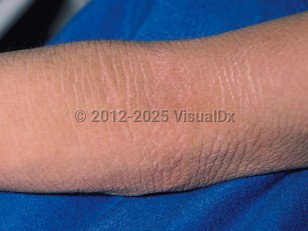Bullous congenital ichthyosiform erythroderma, also known as epidermolytic ichthyosis and bullous ichthyosiform erythroderma (and formerly known as epidermolytic hyperkeratosis), is a rare congenital disorder of keratinocytes presenting with blistering at birth and then with hyperkeratosis later in life. It presents in the neonatal period with erythema, blistering, and widespread areas of denuded skin. Some neonates may also have subtle hyperkeratosis, which may help to clinically distinguish it from other blistering disorders in neonates. After the neonatal period, infants have more verrucous scaling, particularly in the intertriginous areas. Blistering abates with time in many patients.
It is inherited in an autosomal dominant pattern, with a high (50%) frequency of spontaneous mutations. The defect is a point mutation coding for either keratin 1 (K1) or keratin 10 (K10). At least 2 clinical variants exist:
- Epidermolytic ichthyosis without severe palm and sole hyperkeratosis (NPS type)
- Epidermolytic ichthyosis with severe palm and sole hyperkeratosis (PS type)
Ichthyosis hystrix is a variant of the disorder with very long "porcupine-like" spines composed of columns of stratum corneum. Ichthyosis bullosa of Siemens is a variant with scaling and very superficial erosions related to genetic defects of keratin 2e, a keratin confined to the more superficial epidermal layers.
Rare patients with autosomal dominant ichthyosiform erythroderma with K1 or K10 mutations have small confetti-like macules that may increase in number with age. Frameshift mutations in the affected keratin gene are responsible for the new lesions.



